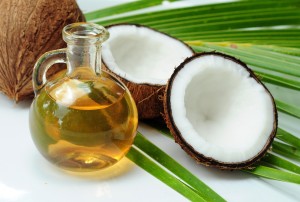
All things coconut have become the rage recently. In countries where this palm has been traditionally grown, the uses have been quite numerous. In the hair industry, coconut oil has become a superstar. But what makes it so useful to hair?
Preparation of Coconut oil
The oil is usually produced from the firm kernel (flesh or meat) found in the mature coconut. The kernel is dried using various methods and then pressed to release the oil. More traditional methods usually involve blending the kernel in water, making coconut milk, then boiling this down allowing the oil to separate and float to the top.
Properties of Coconut oil
Coconut oil contains several different length chain fatty acids. It is mostly composed of medium chain saturated fatty acids such as lauric, myristic and palmitic acids. It’s melting point is 24 deg C, which means that in certain climates it solidifies quite easily. So don’t be alarmed if it comes as a solid and not a liquid in colder countries.
So how does coconut oil help hair?
This is where the story behind coconut oil becomes quite interesting. Studies showed that coconut oil when applied to hair has protective properties. In one particular study, it was shown that it reduces the amount of protein lost from mechanical damage while combing the hair. The study was done on virgin, bleached and permed hair. In all instances, the damage was reduced.
In another study, it was found by way of mass spectrophtometry, that it penetrates the hair shaft better than mineral oil. This just confirmed what people already experience. So many persons use a lot of products containing mineral oil on their hair. They often describe that the hair feels oily but somehow dry at the same time. Seems paradoxical but I’ve experienced this first hand as well. The oil just sits on top of the hair and because there is no moisture (water), the hair just feels crunchy and dry.
And yet in another study, it was shown that although applying oils to the hair blocks penetration of atmospheric water, coconut oil allowed more water into the hair than mineral oil. This of course confirms why petroleum based products such as petrolatum or mineral oil have been used traditionally as pressing oils.
So how can you use coconut oil?
Coconut oil can be added to your hair care regimen in many ways:
1. Pre-shampoo Treatment
The most popular recipe on the internet is mixing equal amounts of coconut oil and honey. Or you could just use the plain oil itself. I must say that this recipe always melted away any tangles I had.
2. Hot oil Treatment
3. Carrier oil for essential oils
Remember essential oils are concentrated oils that should not be used without diluting. Coconut oil is one such oil that can be used.
4. Boost deep conditioner
Your deep conditioner not acting right? Add some coconut oil.
5. Daily sealing oil- Used as a last step it will help keep the moisturiser or leave-in-conditioner longer in the hair.

